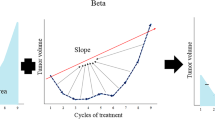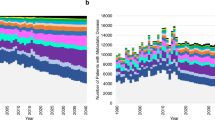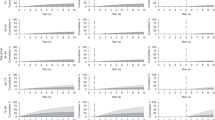Abstract
Background
Previous studies of non-small cell lung cancer (NSCLC) focused on CEA measured at a single time point, ignoring serial CEA measurements.
Methods
This retrospective cohort included 2959 patients underwent surgery for stage I-III NSCLC. CEA trajectory patterns and long-term cumulative CEA burden were evaluated using the latent class growth mixture model.
Results
Four CEA trajectory groups were identified, named as low-stable, decreasing, early-rising and later-rising. Compared with the low-stable group, the adjusted hazard ratios associated with death were 1.27, 4.50, and 3.68 for the other groups. Cumulative CEA burden were positively associated with the risk of death in patients not belonging to the low-stable group. The 5-year overall survival (OS) rates decreased from 62.3% to 33.0% for the first and fourth quantile groups of cumulative CEA burden. Jointly, patients with decreasing CEA trajectory could be further divided into the decreasing & low and decreasing & high group, with 5-year OS rates to be 77.9% and 47.1%. Patients with rising CEA trajectory and high cumulative CEA were found to be more likely to develop bone metastasis.
Conclusions
Longitudinal trajectory patterns and long-term cumulative burden of CEA were independent prognostic factors of NSCLC. We recommend CEA in postoperative surveillance of NSCLC.
This is a preview of subscription content, access via your institution
Access options
Subscribe to this journal
Receive 24 print issues and online access
$259.00 per year
only $10.79 per issue
Buy this article
- Purchase on Springer Link
- Instant access to full article PDF
Prices may be subject to local taxes which are calculated during checkout


Similar content being viewed by others
Data availability
The data underlying this article cannot be shared publicly due to individuals’ privacy that participated in the study. The data will be shared at a reasonable request to the corresponding author.
Code availability
All statistical analyses were performed using R software (version 4.1.3), with two-sided statistical significance set at a P value < 0.05. LCGMM and JLCMM were implemented with package “lcmm” (version 1.9.2). The χ2 proportion test was performed with Harrell’s R package “rms” (version 6.5.0).
References
Siegel RL, Miller KD, Wagle NS, Jemal A. Cancer statistics, 2023. CA Cancer J Clin. 2023;73:17–48.
Sung H, Ferlay J, Siegel RL, Laversanne M, Soerjomataram I, Jemal A, et al. Global Cancer Statistics 2020: GLOBOCAN Estimates of Incidence and Mortality Worldwide for 36 Cancers in 185 Countries. CA Cancer J Clin. 2021;71:209–49.
Chen P, Liu Y, Wen Y, Zhou C. Non-small cell lung cancer in China. Cancer Commun. 2022;42:937–70.
Grunnet M, Sorensen JB. Carcinoembryonic antigen (CEA) as tumor marker in lung cancer. Lung Cancer. 2012;76:138–43.
Molina R, Auge JM, Bosch X, Escudero JM, Vinolas N, Marrades R, et al. Usefulness of serum tumor markers, including progastrin-releasing peptide, in patients with lung cancer: correlation with histology. Tumour Biol. 2009;30:121–9.
National-Comprehensive-Cancer-Network (NCCN). NCCN Clinical Practice Guidelines in Oncology (NCCN Guidelines): Non-Small Cell Lung Cancer. (Version 2.2023). Fort Washington, PA: National Comprehensive Cancer Network (2023).
Postmus PE, Kerr KM, Oudkerk M, Senan S, Waller DA, Vansteenkiste J, et al. Early and locally advanced non-small-cell lung cancer (NSCLC): ESMO Clinical Practice Guidelines for diagnosis, treatment and follow-up. Ann Oncol. 2017;28:iv1–iv21.
Jiao Z, Cao S, Li J, Hu N, Gong Y, Wang L, et al. Clinical Associations of Preoperative and Postoperative Serum CEA and Lung Cancer Outcome. Front Mol Biosci. 2021;8:686313.
Wang CY, Huang MS, Huang MH, Lee HC, Hsu HS. Persistently high serum carcinoembryonic antigen levels after surgery indicate poor prognosis in patients with stage I non-small-cell lung cancer. J Surg Res. 2010;163:e45–e50.
Tomita M, Ayabe T, Chosa E, Nakamura K. Postoperative Serum CEA level is a more significant prognostic factor than post/preoperative serum CEA ratio in non-small cell cancer patients. Asian Pac J Cancer Prev. 2015;16:7809–12.
Kozu Y, Maniwa T, Takahashi S, Isaka M, Ohde Y, Nakajima T. Prognostic significance of postoperative serum carcinoembryonic antigen levels in patients with completely resected pathological-stage I non-small cell lung cancer. J Cardiothorac Surg. 2013;8:106.
Nasralla A, Lee J, Dang J, Turner S. Elevated preoperative CEA is associated with subclinical nodal involvement and worse survival in stage I non-small cell lung cancer: a systematic review and meta-analysis. J Cardiothorac Surg. 2020;15:318.
Wang XB, Li J, Han Y. Prognostic significance of preoperative serum carcinoembryonic antigen in non-small cell lung cancer: a meta-analysis. Tumour Biol. 2014;35:10105–10.
Li C, Zhang D, Pang X, Pu H, Lei M, Fan B, et al. Trajectories of perioperative serum tumor markers and colorectal cancer outcomes: a retrospective, multicenter longitudinal cohort study. EBioMedicine. 2021;74:103706.
Ozeki N, Fukui T, Taniguchi T, Usami N, Kawaguchi K, Ito S, et al. Significance of the serum carcinoembryonic antigen level during the follow-up of patients with completely resected non-small-cell lung cancer. Eur J Cardiothorac Surg. 2014;45:687–92.
Liu L, Gao S, He J, Hu J, Ge D, Li H, et al. Chinese thoracic surgery experts consensus on postoperative follow-up plans for non-small cell lung cancer patients. Chin J Clin Thorac Cardiovasc Surg. 2021;28:4–10. (in Chinese with English abstract)
Proust-Lima C, Philipps V, Liquet B. Estimation of extended mixed models using latent classes and latent processes: the R package lcmm. J Stat Softw. 2017;78:1–56.
Cook NR, Rosner BA, Chen W, Srinivasan SR, Berenson GS. Using the area under the curve to reduce measurement error in predicting young adult blood pressure from childhood measures. Stat Med. 2004;23:3421–35.
Pages F, Mlecnik B, Marliot F, Bindea G, Ou FS, Bifulco C, et al. International validation of the consensus Immunoscore for the classification of colon cancer: a prognostic and accuracy study. Lancet. 2018;391:2128–39.
Harrell F E. rms: Regression Modeling Strategies. R package version 6.5-0. https://CRAN.R-project.org/package=rms (2023).
Wang P, Shen W, Boye ME. Joint modeling of longitudinal outcomes and survival using latent growth modeling approach in a mesothelioma trial. Health Serv Outcomes Res Methodol. 2012;12:182–99.
Sawabata N, Maeda H, Yokota S, Takeda S, Koma M, Tokunaga T, et al. Postoperative serum carcinoembryonic antigen levels in patients with pathologic stage IA nonsmall cell lung carcinoma: subnormal levels as an indicator of favorable prognosis. Cancer. 2004;101:803–9.
Tomita M, Matsuzaki Y, Shimizu T, Hara M, Ayabe T, Onitsuka T. Prognostic determinants for lung cancer patients with preoperative high serum carcinoembryonic antigen levels. Thorac Cardiovasc Surg. 2005;53:300–4.
Okada M, Nishio W, Sakamoto T, Uchino K, Yuki T, Nakagawa A, et al. Prognostic significance of perioperative serum carcinoembryonic antigen in non-small cell lung cancer: analysis of 1,000 consecutive resections for clinical stage I disease. Ann Thorac Surg. 2004;78:216–21.
Li Z, Li C, Pu H, Pang X, Wang Y, Zhang D, et al. Trajectories of perioperative serum carcinoembryonic antigen and colorectal cancer outcome: A retrospective, multicenter longitudinal cohort study. Clin Transl Med. 2021;11:e293.
Chen H, Jiang Y, Jia K, Zhang K, Matsuura N, Jeong JY, et al. Prognostic significance of postoperative longitudinal change of serum carcinoembryonic antigen level in patients with stage I lung adenocarcinoma completely resected by single-port video-assisted thoracic surgery: a retrospective study. Transl Lung Cancer Res. 2021;10:3983–94.
Thompson JA, Grunert F, Zimmermann W. Carcinoembryonic antigen gene family: molecular biology and clinical perspectives. J Clin Lab Anal. 1991;5:344–66.
Blumenthal RD, Hansen HJ, Goldenberg DM. Inhibition of adhesion, invasion, and metastasis by antibodies targeting CEACAM6 (NCA-90) and CEACAM5 (Carcinoembryonic Antigen). Cancer Res. 2005;65:8809–17.
Arrieta O, Saavedra-Perez D, Kuri R, Aviles-Salas A, Martinez L, Mendoza-Posada D, et al. Brain metastasis development and poor survival associated with carcinoembryonic antigen (CEA) level in advanced non-small cell lung cancer: a prospective analysis. BMC Cancer. 2009;9:119.
Ferreira IG, Carrascal M, Mineiro AG, Bugalho A, Borralho P, Silva Z, et al. Carcinoembryonic antigen is a sialyl Lewis x/a carrier and an E‑selectin ligand in non‑small cell lung cancer. Int J Oncol. 2019;55:1033–48.
Ohwada A, Takahashi H, Nagaoka I, Iwabuchi K, Mikami O, Kira S. Effect of cigarette smoke on the mRNA and protein expression of carcinoembryonic antigen (CEA), a possible chemoattractant for neutrophils in human bronchioloalveolar tissues. Thorax. 1995;50:651–7.
Hao C, Zhang G, Zhang L. Serum CEA levels in 49 different types of cancer and noncancer diseases. Prog Mol Biol Transl Sci. 2019;162:213–27.
Acknowledgements
This study is a joint effort of many investigators and staff members, and their contribution is gratefully acknowledged. We especially thank all patients who participated in this study.
Funding
This work was funded by the National Natural Science Foundation of China [grant numbers [82222064, 82073569], Shandong University Distinguished Young Scholars, the Outstanding Youth Science Foundation of Yunnan Basic Research Project [202101AW070001], the Reserve Talent Project for Young and Middle-aged Academic and Technical Leaders [2012005AC160023], the Key Science Foundation of Yunnan Basic Research [202101AS070040], and the Innovative Research Team of Yunnan Province [202405AS350016].
Author information
Authors and Affiliations
Contributions
LC, YD, LZ, ZT did the concept and study design. LC, LZ, ZD, PX, PH and LM participated in the collection and assembly of data. LC, YD, LZ, ZT designed the latent class growth mixed model. LC, YD, LZ, ZT, FB, LJ did the statistical analysis and gave interpreted the results. LC draughted the manuscript, and ZT, LZ revised the manuscript. All authors reviewed and commented on the manuscript, and approved its final submission.
Corresponding authors
Ethics declarations
Competing interests
The authors declare no competing interests.
Ethics approval and consent to participants
This retrospective study was approved by the ethics committee of Yunnan Cancer Hospital. The requirement for informed consent was waived by the board, owing to the study’s retrospective nature. All the patient data in the survey were anonymized.
Additional information
Publisher’s note Springer Nature remains neutral with regard to jurisdictional claims in published maps and institutional affiliations.
Supplementary information
Rights and permissions
Springer Nature or its licensor (e.g. a society or other partner) holds exclusive rights to this article under a publishing agreement with the author(s) or other rightsholder(s); author self-archiving of the accepted manuscript version of this article is solely governed by the terms of such publishing agreement and applicable law.
About this article
Cite this article
Li, C., Liu, L., You, R. et al. Trajectory patterns and cumulative burden of CEA during follow-up with non-small cell lung cancer outcomes: A retrospective longitudinal cohort study. Br J Cancer (2024). https://doi.org/10.1038/s41416-024-02678-8
Received:
Revised:
Accepted:
Published:
DOI: https://doi.org/10.1038/s41416-024-02678-8



